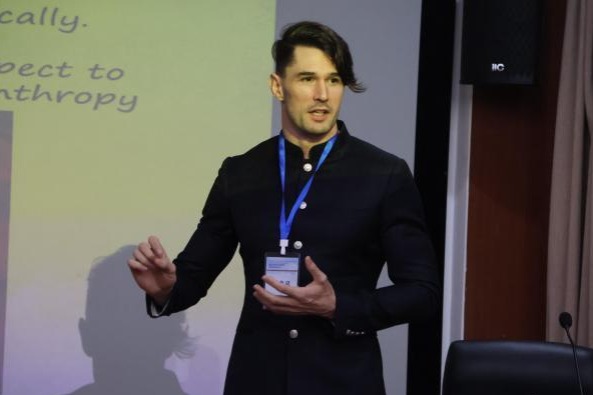Innovation transforms embroidered thangka into income source for SW China villagers

LHASA -- In a sunlit workshop in Yadong, a border county in Southwest China's Xizang autonomous region, 36-year-old Sonam Tsering threaded colored silk through woolen cloth, his hands steady and his vision bold.
What emerges is neither a traditional painting thangka nor conventional embroidery, but a dazzling fusion, one that blends centuries-old Tibetan art with his own modern twist.
Proudly pointing at an embroidered thangka decorated with non-traditional motifs of Chinese knots, Sonam Tsering said the embroidered thangka, once a vibrant part of Tibetan art, had become rare in many places, with most surviving pieces preserved only in museums.
"For years, I had dreamed of creating my own works that blended tradition with innovation," the artist recalled. Notably, he now leads a workshop of more than 30 apprentices, mostly village women, who produce embroidered thangka works that are gaining buyers from Xizang, East China's Shanghai, and even overseas.
A decade ago, Sonam Tsering was a young graduate of Xizang University, steeped in the study of thangka painting.
During his university years, Sonam Tsering encountered this precious art form. Later, he apprenticed under Gade, a renowned Tibetan artist and professor at Xizang University.
"I used to think traditional thangka was fixed, something that couldn't be changed," Sonam Tsering said.
His path to becoming a cultural innovator began at the university seminar, where he studied traditional thangka painting alongside classmates from Japan, India and the United States. This exposure to international classmates reshaped his outlook.
"But tradition itself is shaped by each era. What we call tradition today was once someone's contemporary creation. Culture can change -- and it should reflect the lives and thoughts of people now," the artist said.
Fascinated not only by the meticulous brushwork of painted thangkas but also by rare embroidery styles preserved in museum collections, he broadened his skills to include enamel-inspired cloisonné painting techniques and other fine arts, such as Chinese ink painting and oil painting.
After graduating in 2012, Sonam Tsering returned to his hometown to work as a grassroots civil servant. However, in his spare time, he never stopped creating.
In 2013, his works were exhibited in Italy, attracting early recognition abroad. For years, he relied on his own savings to hire assistants and maintain production. Then, in 2021, local officials noticed his work and encouraged him to teach villagers.
By 2023, with support from Shanghai's assistance programs, he secured over 200,000 yuan (about $28,144) in funding to establish a workshop.
Today, the workshop employs more than 30 local women, many of whom were already skilled in needlework. With additional training, they are now able to craft embroidered thangkas -- incorporating Tibetan motifs such as auspicious clouds and the six-syllable mantra, "Om Mani Padme Hum," and sometimes fetching between 400 and 4,000 yuan apiece.
Apprentices earn 100 yuan a day, a solid source of income in the region. In 2023 alone, the workshop secured orders worth more than 200,000 yuan from the paired-up assistance program. By the year's end, the earnings were distributed as dividends among the apprentices.
For 27-year-old Qungda, who joined the workshop in 2023, the experience has been life-changing. Beyond earning a steady income, she has gained new skills and a sense of purpose. "Otherwise, I would just be doing housework and farm chores at home," she said. The workshop has opened new doors for women in the village -- giving them opportunities to support their families while also preserving Tibetan culture.
"Passing on culture doesn't mean only professionals can do it," he said. "Everyone can take part. Tradition thrives when it collides with new ideas."
Looking ahead, the workshop aims to expand and involve more participants. Sonam Tsering hopes to take his apprentices to places such as Suzhou and Shanghai, both in east China, to learn embroidery traditions like Suzhou-style silk embroidery. Response has been overwhelming, with villagers of all ages signing up eagerly -- some applicants are even in their 60s, he added.
His journey mirrors a larger shift on the plateau. Since 2020, initiatives to support Xizang's development have invested more than 37.2 billion yuan in projects across nine key industries, fostering nearly 900 local specialties and helping transform cultural and natural resources into engines of sustainable development, according to local authorities.
- Guangdong reaffirms easing process to boost innovation and entrepreneurship
- Taiwan and mainland united by goddess Mazu, common ancestral roots
- First robotics debate competition holds semifinals in Beijing
- Top court seeks to ensure quality of construction projects
- Shanghai Disney Resort reaches 100 million visitors
- Xinjiang's desert poplar forests shine with autumn tourism





































